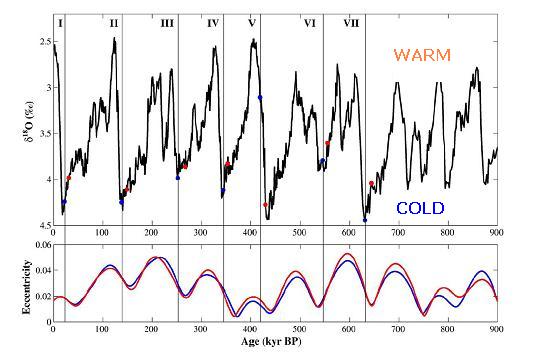

 Professor
ProfessorDepartment of Oceanography
University of Hawaii at Manoa

Paleoceanography
Paleoproxies. Information on Earth's climate in the past is derived from various climate indicators, called Paleoproxies. This includes ice cores, tree rings, corals, sediments and more (for overview, see NOAA). My work has so far focused on proxies in deep-sea sediments. A great deal of what we know about Earth's climatic history is based on fossil shells of organisms called foraminifera.

The fossil CaCO3 shells
of foraminifera can be extracted from deep-sea sediments. Their chemistry and
isotopic composition reveal information about climatic and environmental
conditions in the past.
The geochemical proxy-information preserved in the
shells needs to be deciphered and translated into a language that speaks
about climate - similar to the deciphering of an ancient language.
In many proxies (including foraminifera), the interpretation is
complicated by the fact that the primary climate information is recorded
by a living organism, which can mask or modify the signal.
Live processes in foraminifera
can affect the climate signal recorded in their shells (photo shows
a specimen of the species Globigerina bulloides).
Image credit: Howard J. Spero.


We are currently funded by the National
Science Foundation to decipher an isotope phenomenon in
biogenic CaCO3 (see Active Research Grants,
NSF: OCE05-25647).
Pleistocene Glacial Cycles. During the ice ages, large continental ice sheets covered parts of the Northern Hemisphere. The H2O that formed the ice (after it was deposited as snow in the high-latitudes) was originally evaporated as liquid water from the ocean. Consequently, sea level dropped during glacial periods compared to warm (interglacial) periods.

For example, at the Last Glacial Maximum (about
18,000 years ago, left), Canada, Scandinavia, and parts of Siberia
were covered with thick ice caps and sea-level was approximately 120 m lower
than today.
The large swings in temperature and sea-level accompanying the glacial cycles are recorded in the CaCO3 shells of fossil foraminifera. The oxygen isotope ratio of 18O to 16O in their carbonate shells varies as a function of temperature and isotopic composition of the seawater (see Isotope Geochemistry). As a result, the measurement of oxygen isotope ratios in shells of foraminifera from the sediment record has allowed the reconstruction of past climate cycles over millions of years.
The large swings in temperature and sea-level accompanying the glacial cycles are recorded in the CaCO3 shells of fossil foraminifera. The oxygen isotope ratio of 18O to 16O in their carbonate shells varies as a function of temperature and isotopic composition of the seawater (see Isotope Geochemistry). As a result, the measurement of oxygen isotope ratios in shells of foraminifera from the sediment record has allowed the reconstruction of past climate cycles over millions of years.

The abrupt switches from cold, glacial conditions
to warm interglacials (vertical lines) are called terminations.
The pacemaker behind these major ice age terminations is still
somewhat of a mystery. It has been suggested that the eccentricity
variation of Earth's orbit has caused the terminations. However,
we consider this to be unlikely. The direct insolation forcing
is much too small and eccentricity is also partly out of phase with
the onset of the terminations (see figure). For example, Termination III
occurs after an eccentricity minimum, Termination VI before; Termination IV
occurs half-way between maximum and minimum. Instead, we have proposed
that insolation changes occurring in concert in the Northern and Southern
Hemisphere have triggered the terminations; see Schulz and Zeebe (2006) under
Publications.
PETM.
The Paleocene-Eocene Thermal Maximum (PETM) was an
extreme warm period in Earth's history that occurred about 55 million years ago.
On geologic time scales, the onset of the event was extremely rapid.
Earth's surface temperature rose globally by 5-9 degrees Celsius
within a few thousand years. Simultaneously, large amounts of carbon
were released into the ocean-atmosphere system.
At present, humans are adding large amounts of greenhouse gases to the atmosphere, which leads to warming of the planet's surface. The PETM may turn out to be a valuable lesson from the past on climate change and carbon cycling, which helps us to understand the present and develop better predictions for the future.
At present, humans are adding large amounts of greenhouse gases to the atmosphere, which leads to warming of the planet's surface. The PETM may turn out to be a valuable lesson from the past on climate change and carbon cycling, which helps us to understand the present and develop better predictions for the future.

The world looked different 55 million
years ago. Africa and South America were in closer proximity than today and
the basin of the Atlantic Ocean was smaller. An ancient ocean, called the
Tethys, separated Europe/Asia from North Africa. Numbers show some
sites drilled by the Ocean Drilling Program (ODP) where PETM sections were
recovered.
It has been suggested that catastrophic dissociation
of oceanic methane hydrate was responsible for the massive carbon release.
We are currently investigating scenarios of carbon release during the PETM using
sediment and carbon cycle models. Funding for this project is provided by
the National Science Foundation (see Active Research
Grants, NSF: EAR06-28394).

An adequate data base is the key prerequisite for our
modeling efforts. For example, based on deep-sea carbonate records across
the PETM (see figure), we were able to show that carbonate dissolution as
a response to ocean acidification was not globally homogeneous during the
PETM. Rather,
dissolution was stronger in the Atlantic compared to the Southern Ocean and
Pacific (Zeebe and Zachos, 2007; see
Publications).

Department of Oceanography
University of Hawaii at Manoa
1000 Pope Road
Marine Sciences Building 629
Honolulu, HI 96822
